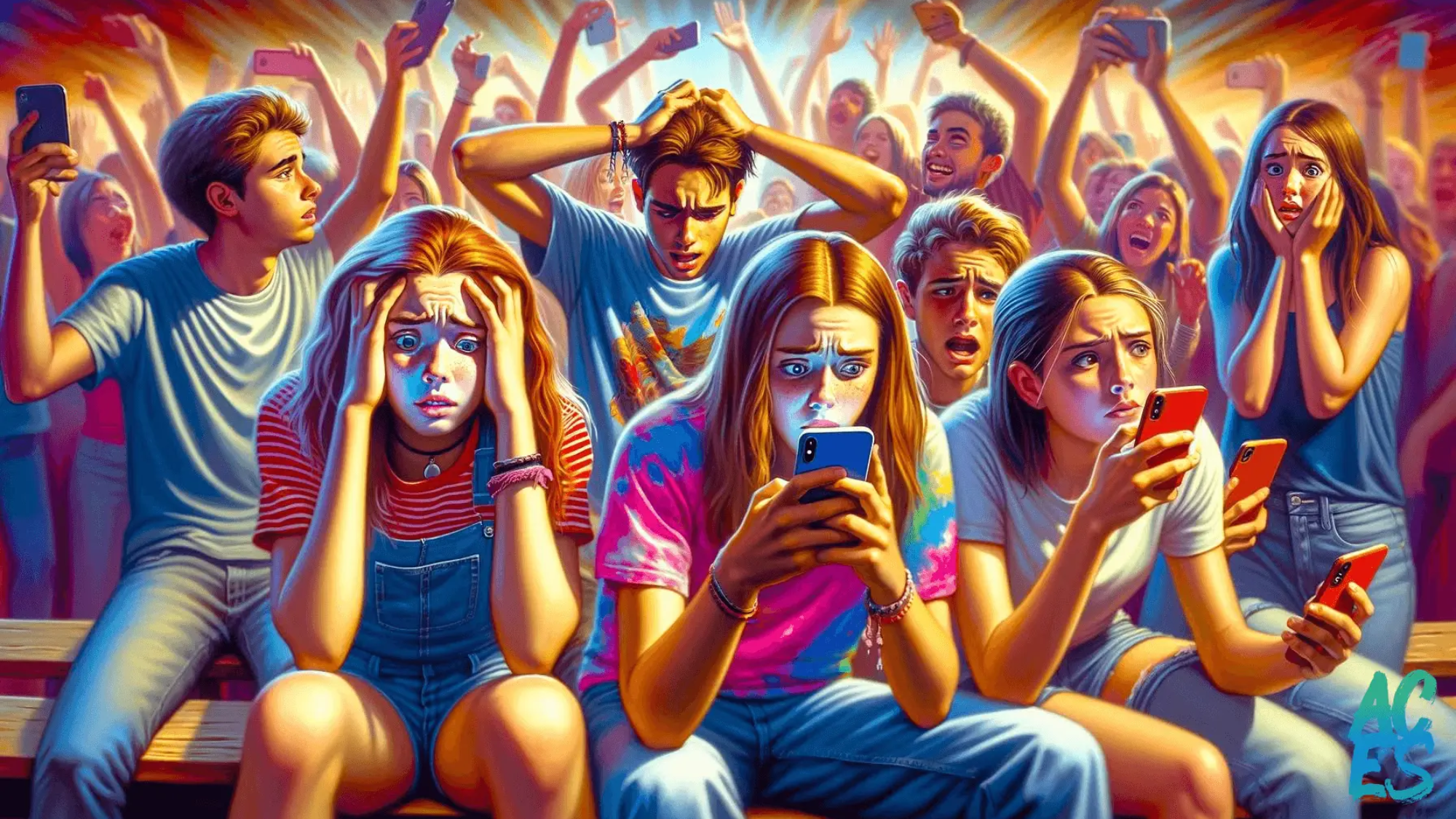Imagine a world where your worth is measured by likes, shares, and emojis. Welcome to the digital playground—social media, where children and teens not only hang out but also vie for virtual validation. Let’s explore how this constant online interaction is reshaping the mental landscapes of our younger generations, a concern we see frequently in areas like Central Florida.
A Virtual Reality Check
It’s not all doom and gloom in the world of hashtags and heart reacts. Social media can be a vibrant space for creativity, connection, and learning. However, beneath the glossy surface of curated feeds lies a complex layer of psychological dynamics. From FOMO (Fear of Missing Out) to digital envy, our kids are navigating a minefield dressed as a playground.
The Bright Side
Social media platforms offer an unprecedented level of connectivity, enabling children and teens to communicate with peers across the globe, share their creative endeavors, and access educational content. This digital landscape can foster a sense of community and belonging, particularly for those who may feel isolated in their offline lives.
The Hidden Challenges
However, the pressures of maintaining a perfect online persona can be overwhelming. The constant comparison to others’ highlight reels can erode self-esteem and lead to feelings of inadequacy. Understanding the social media impact on teen mental health is crucial. A study by Twenge and Campbell (2018) highlights the link between excessive screen time and lower psychological well-being among children and adolescents.
The Likeability Contest
In the race to rack up likes, what’s at stake? Quite a bit, it turns out. The pressure to be ‘liked’ on social media can lead to anxiety and depression in children and teens, making external validation a precarious yardstick for self-worth.
Research Insights
Research by Przybylski and Weinstein (2017) suggests that there is a delicate balance between screen time and mental well-being, often referred to as the Goldilocks Hypothesis. Moderate use of digital screens is associated with higher well-being, while excessive use can lead to negative psychological outcomes.
24/7 Peer Pressure
Gone are the days when peer pressure was confined to school hours. Social media brings these challenges right into our homes, with kids facing an onslaught of peer-influenced decisions around the clock. This constant connectivity can lead to stress, disrupted sleep patterns, and a serious case of ‘comparisonitis,’ sometimes contributing to aggressive or disruptive child behavior.
Sleep Matters
Research by Woods and Scott (2016) indicates that excessive social media use is associated with poor sleep quality, which in turn exacerbates anxiety, depression, and low self-esteem. A meta-analysis by van der Schuur et al. (2019) further confirms that frequent social media use is linked to sleep disturbances and poorer sleep quality among adolescents. Finding a teen psychiatrist in Orlando who understands these digital pressures can be beneficial.
Digital Distractions
While multitasking between homework and checking notifications might seem like child’s play, it’s actually quite the brain drain. Research suggests that digital multitasking can impair cognitive abilities and reduce learning efficiency, turning dinner times into silent swipe-fests. This can sometimes mimic symptoms seen in conditions like ADHD.
Cognitive Overload
Studies such as those by Ophir, Nass, and Wagner (2009) show that media multitasking can negatively impact cognitive control and learning efficiency. Additionally, Cain and Mitroff (2011) found that heavy media multitaskers perform worse on cognitive tasks compared to light media multitaskers.
Empowering the Digital Natives
Fear not! The digital world is here to stay, but so are good parenting and guidance. Encouraging healthy online habits and open communication are key. Setting boundaries around screen time and content can help mitigate some of the adverse effects of social media. Moreover, teaching children about the curated nature of online personas can help them keep reality and virtuality in perspective. Exploring our approach to child and adolescent psychiatry can offer further insights.
Practical Tips
-
Set Clear Boundaries: Establish screen-free zones and times, such as during meals and before bedtime.
-
Promote Offline Activities: Encourage hobbies and activities that don’t involve screens, like reading, sports, or arts and crafts.
-
Open Dialogue: Talk to your children about their online experiences and feelings. Make them feel comfortable sharing both positive and negative encounters.
-
Role Modeling: Demonstrate healthy screen habits yourself. Children often mimic the behavior they see.
Voices of Experience
Hearing from adolescents who have navigated the highs and lows of social media can offer invaluable insights and strategies. These narratives can demystify the digital experience and provide relatable guidance to those feeling overwhelmed.
Conclusion
As we toggle through the tabs of social media’s impact, let’s remember to click ‘like’ on moderation and ‘share’ on open dialogues about mental health. By fostering an environment where children can discuss their online experiences without judgment, we can help them navigate the digital age with resilience and savvy. Understanding the nuances of social media’s impact from a teen psychiatrist’s perspective in the Orlando area is vital for families today.
Seeking Support in Central Florida?
If you or a loved one in the Orlando, Lake Nona, Windermere, Winter Garden, or Winter Park areas are seeking support for challenges related to social media use or teen mental health, ACES Psychiatry offers specialized, compassionate care. We understand the unique challenges faced by individuals and families in our community. Learn more about our approach to Anxiety Treatment or Contact Us today to schedule a consultation.
Disclaimer: This blog post is for informational purposes only and does not constitute medical advice. Please consult with a qualified healthcare professional for any health concerns or before making any decisions related to your health or treatment.
References
- Twenge, J.M., & Campbell, W.K. (2018). “Associations between screen time and lower psychological well-being among children and adolescents: Evidence from a population-based study.” Preventive Medicine Reports, 12, 271-283.
- Woods, H.C., & Scott, H. (2016). “#Sleepyteens: Social media use in adolescence is associated with poor sleep quality, anxiety, depression and low self-esteem.” Journal of Adolescence, 51, 41-49.
- Ophir, E., Nass, C., & Wagner, A.D. (2009). “Cognitive control in media multitaskers.” Proceedings of the National Academy of Sciences, 106(37), 15583-15587.
- Przybylski, A.K., & Weinstein, N. (2017). “A large-scale test of the Goldilocks Hypothesis: Quantifying the relations between digital-screen use and the mental well-being of adolescents.” Psychological Science, 28(2), 204-215.
- Meshi, D., Tamir, D.I., & Heekeren, H.R. (2015). “The Emerging Neuroscience of Social Media.” Trends in Cognitive Sciences, 19(12), 771-782.
- Valkenburg, P.M., & Peter, J. (2009). “The effects of instant messaging on the quality of adolescents’ existing friendships: A longitudinal study.” Journal of Communication, 59(1), 79-97.
- Best, P., Manktelow, R., & Taylor, B. (2014). “Online communication, social media and adolescent wellbeing: A systematic narrative review.” Children and Youth Services Review, 41, 27-36.
- van der Schuur, W.A., Baumgartner, S.E., Sumter, S.R., & Valkenburg, P.M. (2019). “Disrupted sleep: The role of media use before bedtime.” Current Opinion in Psychology, 31, 124-129.
- Cain, M.S., & Mitroff, S.R. (2011). “Distractor filtering in media multitaskers.” Proceedings of the National Academy of Sciences, 108(2), 631-635.





Best Psychiatrist in Orlando. My son loves his therapy Sessions